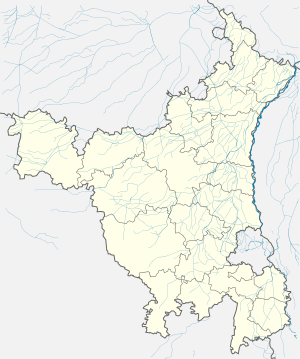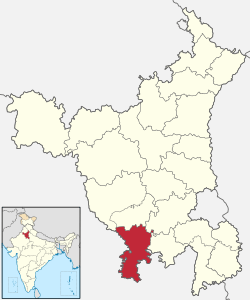Narnaul
Narnaul is a city, a municipal council, and location of headquarters of the Mahendragarh district in the Indian state of Haryana. It is located in the National Capital Region of India.
Narnaul | |
|---|---|
City | |
| Nickname(s): The Saffron City | |
 Narnaul Location of Narnaul in Haryana  Narnaul Narnaul (India) | |
| Coordinates: 28°02′40″N 76°06′20″E | |
| Country | India |
| State | Haryana |
| District | Mahendragarh |
| Seat | Haryana Government |
| Elevation | 318 m (1,043 ft) |
| Population (2011) | |
| • Total | 1,45,897 |
| Languages | |
| • Official | Hindi & English
registration_plate = HR-35 xxxx (for non-commercial vehicles) HR-66 xxxx (for commercial vehicles) |
| Time zone | UTC+05:30 (IST) |
| Postal code of India | 123001 |
| Area code(s) | 01282 |
| ISO 3166 code | IN-HR |
| Sex ratio | 901 ♂/♀ |
| Climate | Cw (Köppen) |
| Precipitation | 570 millimetres (22 in) |
| Avg. summer temperature | 38 °C (100 °F) |
| Avg. winter temperature | 04 °C (39 °F) |
| Website | mahendragarh |
Geography
Narnaul is located at 28.04°N 76.11°E.[1] It has an average elevation of 300 meters (977 feet). The district is rich in mineral resources such as iron ore, copper ore, beryl, tourmaline, muscovite, biotite, albite, calcite, and quartz.
Climate
In winters, the temperature can reach a low of -3 °C. In summer the highest temperature is 50 °C.[2]
| Climate data for Narnaul (1981–2010, extremes 1965–2005) | |||||||||||||
|---|---|---|---|---|---|---|---|---|---|---|---|---|---|
| Month | Jan | Feb | Mar | Apr | May | Jun | Jul | Aug | Sep | Oct | Nov | Dec | Year |
| Record high °C (°F) | 30.6 (87.1) |
34.5 (94.1) |
41.0 (105.8) |
44.0 (111.2) |
48.1 (118.6) |
48.4 (119.1) |
45.0 (113.0) |
43.0 (109.4) |
41.0 (105.8) |
40.5 (104.9) |
37.6 (99.7) |
30.6 (87.1) |
48.1 (118.6) |
| Average high °C (°F) | 20.7 (69.3) |
24.3 (75.7) |
30.7 (87.3) |
37.2 (99.0) |
40.7 (105.3) |
41.3 (106.3) |
36.4 (97.5) |
34.5 (94.1) |
35.4 (95.7) |
33.5 (92.3) |
28.8 (83.8) |
23.2 (73.8) |
32.2 (90.0) |
| Average low °C (°F) | 4.8 (40.6) |
7.1 (44.8) |
12.6 (54.7) |
18.9 (66.0) |
24.3 (75.7) |
26.3 (79.3) |
25.4 (77.7) |
24.7 (76.5) |
23.0 (73.4) |
17.4 (63.3) |
11.3 (52.3) |
6.2 (43.2) |
16.8 (62.2) |
| Record low °C (°F) | 0.0 (32.0) |
0.1 (32.2) |
2.0 (35.6) |
9.8 (49.6) |
11.5 (52.7) |
11.0 (51.8) |
17.0 (62.6) |
18.6 (65.5) |
14.3 (57.7) |
9.3 (48.7) |
0.1 (32.2) |
−0.9 (30.4) |
−0.9 (30.4) |
| Average rainfall mm (inches) | 13.4 (0.53) |
12.2 (0.48) |
8.0 (0.31) |
4.7 (0.19) |
34.0 (1.34) |
55.2 (2.17) |
149.8 (5.90) |
101.3 (3.99) |
30.6 (1.20) |
11.1 (0.44) |
2.3 (0.09) |
6.5 (0.26) |
429.1 (16.89) |
| Average rainy days | 0.8 | 1.2 | 0.6 | 0.5 | 2.3 | 3.3 | 6.1 | 4.8 | 1.9 | 0.9 | 0.2 | 0.4 | 22.9 |
| Average relative humidity (%) (at 17:30 IST) | 47 | 45 | 36 | 33 | 37 | 39 | 55 | 65 | 55 | 55 | 43 | 45 | 46 |
| Source: India Meteorological Department[3][4] | |||||||||||||
Battle of Narnaul
The Battle of Narnaul (also called Battle of Nasibpur) was fought on 16 November 1857, between the British Raj and Indian natives during the First War of Indian Independence.[5] In 1857, Pran Sukh Yadav along with Rao Tula Ram of Rewari and Kushal Singh of Auwa fought with the British at Nasibpur village near Narnaul. The battle was one of the most ferocious battles of the First War of Indian Independence.[6] During the Battle of Narnaul at Nasibpur on 16 November 1857, British lost 70 British soldiers and their commanders Colonel Gerrard and Captain Wallace. 40 British soldiers and officers Captain Craige, Captain Kennedy and Captain Pearse were wounded. Colonel Gerrard died after getting mortally wounded in a military engagement against Kushal Singh of Auwa.[7][5] Later, Pran Sukh Yadav settled at the village of Nihalpura and rehabilitated the kin of dead soldiers.[6]
Rao Krishan Gopal, from Nangal Pathani village of Gurgaon district was the Kotwal of Meerut, who had played a prominent part in collaboration with Raja Nahar Singh of Ballabhgarh, Nawab of Jhajjar, and Rao Shahamat Khan of Mewat, by organising the patriotic forces and participating in several battles against the British troops. He and his younger brother, Rao Ram Lal, were killed in this battle of Nasibpur.[8]
Demographics
As of 2001 India census,[9] Narnaul had a population of 74,581.Males constitute 53% of the population and females 47%. Narnaul has an average literacy rate of 68%, higher than the national average of 59.5%: male literacy is 76%, and female literacy is 58%. In Narnaul, 14% of the population is under 6 years of age.
References
- Falling Rain Genomics, Inc - Narnaul
- http://www.ndtv.com/article/cities/a-town-in-haryana-records-minus-3-degrees-314099
- "Station: Narnaul Climatological Table 1981–2010" (PDF). Climatological Normals 1981–2010. India Meteorological Department. January 2015. pp. 541–542. Archived from the original (PDF) on 5 February 2020. Retrieved 1 March 2020.
- "Extremes of Temperature & Rainfall for Indian Stations (Up to 2012)" (PDF). India Meteorological Department. December 2016. p. M66. Archived from the original (PDF) on 5 February 2020. Retrieved 1 March 2020.
- Dr Malti Malik, History of India, p. 356.
- "Tribune India". Tribune India. 3 December 2007. Retrieved 12 October 2014.
- The Central India Campaign
- 1981, Haryana Review, Volume 15, p. 29.
- "Census of India 2001: Data from the 2011 Census, including cities, villages and towns (Provisional)". Census Commission of India. Archived from the original on 16 June 2004. Retrieved 1 November 2008.
